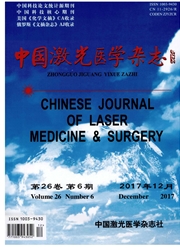

 中文摘要:
中文摘要:
目的探讨光动力效应对靶细胞线粒体损伤的发生机制。方法先将血卟啉单甲醚与ECV304细胞共同孵育12h,采用荧光探针标记技术和细胞器-细胞荧光强度比值法对细胞内HMME进行亚细胞定位和定量分析。应用荧光显微镜汞灯照射以激发光敏剂产生光动力效应,并加入ROS探针H2DCF-DA检测单线态氧的产生。分别在光照前后采集线粒体及DCF的荧光图像并进行荧光强度的定量分析。结果细胞总荧光光强在光照后较光照前降低26.4%;以细胞器光照前的平均荧光光强比值为基准,则光照后线粒体降低了31.1%。线粒体区域在单纯光照和有HMME存在情况下均检测到DCF荧光的增强。结论光动力效应会引起线粒体内光敏剂发生一定程度的光漂白作用,表明线粒体内产生了一定数量的单线态氧,后者导致线粒体损伤。
 英文摘要:
英文摘要:
Objective To explore a mechanism of target cell mitochondrial damage induced by photodynamie effect. Methods ECV304 ceils were incubated with hematoporphyrin monomethyl ether for 12 h. Fluorescence probe labeling techniques and organellecell fluorescence intensity ratio analysis were adopted to investigate the subcellular localization of HMME. Mercury lamp of fluorescence microscopy was used as light source to make photosensitizers excitated and produce photodynamic effects. Fluorescence probe of ROS H2 DCF-DA was used to detect production of singlet oxygen. Fluorescence images of mitochondrion and DCF were recorded before and after irradiation. Results Total fluorescence intensity of cells was decreased by 26.4% after irradiation. With mitochondrial average fluorescence intensity ratio before irradiation as the standard,the total fluorescence intensity of mitochondrion was decreased by 31.1% after irradiation. Enhancement of fluorescence of DCF was detected in mitochondrion with HMME or with single light after irradiation. Conclusion Photodynamic effects may cause a certain degree of photobleaehing of photosensitizers in mitoehondrion, which indicates that a certain quantity of singlet oxygen exist in mitochondrion to induce its damage.
 同期刊论文项目
同期刊论文项目
 同项目期刊论文
同项目期刊论文
 Synthesis and photodynamic action of diphenyl-2,3-dihydroxychlorin: a potential tumor photosensitize
Synthesis and photodynamic action of diphenyl-2,3-dihydroxychlorin: a potential tumor photosensitize somparison between ultra-high sensitivity fluorescence microscopy and laser scanning confocal micros
somparison between ultra-high sensitivity fluorescence microscopy and laser scanning confocal micros 期刊信息
期刊信息
